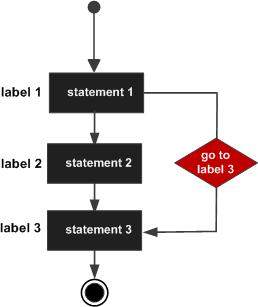
- C++ 基礎
- C++ 首頁
- C++ 概述
- C++ 環境設定
- C++ 基本語法
- C++ 註釋
- C++ Hello World
- C++ 省略名稱空間
- C++ 常量/字面量
- C++ 關鍵字
- C++ 識別符號
- C++ 資料型別
- C++ 數值資料型別
- C++ 字元資料型別
- C++ 布林資料型別
- C++ 變數型別
- C++ 變數作用域
- C++ 多個變數
- C++ 基本輸入/輸出
- C++ 修飾符型別
- C++ 儲存類
- C++ 運算子
- C++ 數字
- C++ 列舉
- C++ 引用
- C++ 日期和時間
- C++ 控制語句
- C++ 決策制定
- C++ if 語句
- C++ if else 語句
- C++ 巢狀 if 語句
- C++ switch 語句
- C++ 巢狀 switch 語句
- C++ 迴圈型別
- C++ while 迴圈
- C++ for 迴圈
- C++ do while 迴圈
- C++ Foreach 迴圈
- C++ 巢狀迴圈
- C++ break 語句
- C++ continue 語句
- C++ goto 語句
- C++ 建構函式
- C++ 建構函式和解構函式
- C++ 複製建構函式
- C++ 檔案處理
- C++ 檔案和流
- C++ 從檔案中讀取
C++ goto 語句
goto 語句提供從 goto 到同一函式中帶標籤語句的無條件跳轉。
注意 - 強烈建議不要使用 goto 語句,因為它使得難以跟蹤程式的控制流程,從而使程式難以理解和修改。任何使用 goto 的程式都可以重寫,使其不需要 goto。
語法
C++ 中 goto 語句的語法如下:
goto label; .. . label: statement;
其中 label 是一個識別符號,用於標識帶標籤的語句。帶標籤的語句是任何以識別符號後跟冒號 (:) 開頭的語句。
流程圖

示例
#include <iostream>
using namespace std;
int main () {
// Local variable declaration:
int a = 10;
// do loop execution
LOOP:do {
if( a == 15) {
// skip the iteration.
a = a + 1;
goto LOOP;
}
cout << "value of a: " << a << endl;
a = a + 1;
}
while( a < 20 );
return 0;
}
當以上程式碼被編譯和執行時,會產生以下結果:
value of a: 10 value of a: 11 value of a: 12 value of a: 13 value of a: 14 value of a: 16 value of a: 17 value of a: 18 value of a: 19
goto 的一個好的用途是從深度巢狀的例程中退出。例如,考慮以下程式碼片段:
for(...) {
for(...) {
while(...) {
if(...) goto stop;
.
.
.
}
}
}
stop:
cout << "Error in program.\n";
消除 goto 將迫使執行許多額外的測試。簡單的 break 語句在這裡不起作用,因為它只會導致程式退出最內層迴圈。
廣告